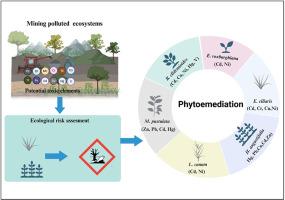采矿驱动的污染对生态系统健康的影响及其通过绿色技术的恢复:基于自然的可持续解决方案
IF 7.3
2区 环境科学与生态学
Q1 ENVIRONMENTAL SCIENCES
引用次数: 0
摘要
绿色科技为减轻环境污染提供了有效的解决方案。本研究旨在评估滇西南地区铅锌、石灰岩和锰矿开采污染生态系统的生态影响,并研究云南西南地区优势植物的修复能力。收集了161个污染和非污染地点的土壤和植被数据。采用原子吸收分光光度法对样品中的潜在有毒元素进行了分析。生态风险评价结果表明,Mn、Pb、Zn、Ni、Cu、Co、Cr、Tl和Cd是环境污染的主要来源。结构方程模型表明,植物物种丰度的增加显著降低了与pte相关的生态风险(β= -0.73)。植物修复评价表明毛绿毛藻是Cd、Cr、Cu和Ni的超蓄积者。刺梨和白花对Cd和Ni均表现出显著的超积累能力。在矿区污染的生态系统中发现了Boehmeria clidemioides (Ni, Hg, V, Cd, Cu), Macaranga pustulata (Zn, Pb, Cd, Hg)和Helicteres angustifolia (Hg, Pb, Cu, Cd, Zn)的提取物。混合效应模型进一步证实了植物丰度与Pb、Zn、Mn、Cd之间存在显著的正相关关系,为矿山污染系统的植物修复提供了有效的解决方案,以实现pte污染的可持续治理和污染生态系统的恢复。本文章由计算机程序翻译,如有差异,请以英文原文为准。

Mining driven pollution impact on ecosystem health and its retrieval through green technology: A nature based sustainable solution
Green technology provides an effective solution to mitigate environmental pollution. This study aims to assess the ecological impact of lead-zinc, limestone and manganese mining polluted ecosystems and examines the phytoremediation ability of selected dominant plant species in Southwest Yunnan, China. Soil and vegetation data were collected from 161 polluted and non-polluted sites. The potential toxic elements (PTEs) were analyzed using atomic absorption spectrophotometry. Ecological risk assessment identified that the Mn, Pb, Zn, Ni, Cu, Co, Cr, Tl and Cd were the most significant contributors to environmental pollution. The structural equation modeling shows that increasing plant species abundance significantly decreases ecological risks (β= -0.73) associated with PTEs. The phytoremediation assessment identified Eremochloa ciliaris as a hyperaccumulator for Cd, Cr, Cu and Ni. While, Engelhardia roxburghiana and Leucosceptrum canum showed significant hyperaccumulation ability for Cd and Ni, respectively. Boehmeria clidemioides was recorded as a phytoextractor of (Ni, Hg, V, Cd, Cu), Macaranga pustulata (Zn, Pb, Cd, Hg), and Helicteres angustifolia (Hg, Pb, Cu, Cd, Zn) in the mining polluted ecosystems. The mixed effect model further confirmed a significant positive relationship between plant abundance with Pb, Zn, Mn and Cd. It is concluded that the identified dominant species offer an effective solution for the phytoremediation of mining polluted systems to manage PTEs contamination and rehabilitate the polluted ecosystems in a sustainable way.
求助全文
通过发布文献求助,成功后即可免费获取论文全文。
去求助
来源期刊

Environmental Pollution
环境科学-环境科学
CiteScore
16.00
自引率
6.70%
发文量
2082
审稿时长
2.9 months
期刊介绍:
Environmental Pollution is an international peer-reviewed journal that publishes high-quality research papers and review articles covering all aspects of environmental pollution and its impacts on ecosystems and human health.
Subject areas include, but are not limited to:
• Sources and occurrences of pollutants that are clearly defined and measured in environmental compartments, food and food-related items, and human bodies;
• Interlinks between contaminant exposure and biological, ecological, and human health effects, including those of climate change;
• Contaminants of emerging concerns (including but not limited to antibiotic resistant microorganisms or genes, microplastics/nanoplastics, electronic wastes, light, and noise) and/or their biological, ecological, or human health effects;
• Laboratory and field studies on the remediation/mitigation of environmental pollution via new techniques and with clear links to biological, ecological, or human health effects;
• Modeling of pollution processes, patterns, or trends that is of clear environmental and/or human health interest;
• New techniques that measure and examine environmental occurrences, transport, behavior, and effects of pollutants within the environment or the laboratory, provided that they can be clearly used to address problems within regional or global environmental compartments.
 求助内容:
求助内容: 应助结果提醒方式:
应助结果提醒方式:


